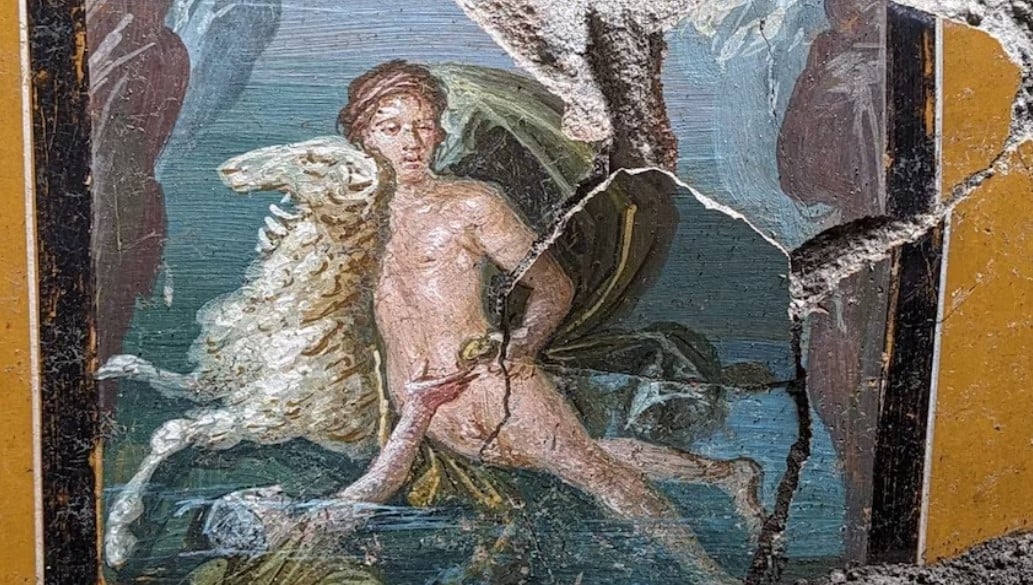
A lavish fresco depicting mythological Greek siblings has been unearthed during an excavation in the ruins of the ancient city Pompeii.
Still colorful after more than 2,000 years, the painting was among several frescoes found during restoration work around the mansion of the House of Leda.
“Among the IV Style decorations that cover the back walls, the mythological painting depicting Phrixus and Helle fleeing on the ram of the Golden Fleece stands out,” the Pompeii Archaeological Park wrote in a statement on its website.
Fresco in Pompeii depicts the Greek myth of Phrixus and Helle
The art shows a scene from the Greek myth of Phrixus and his twin sister Helle who fled their stepmother Ino on the magical ram with a Golden Fleece.
The fresco depicts Phrixus on the ram while his sister is seen falling into the water. It is painted as if it were a framed picture, hung on a yellow wall.
The Golden Fleece was the fleece of a specific ram named Chrysomallos. This ram was the son of Poseidon, the god of the sea.
A cloud nymph named Nephele sent the ram to save her twin children, Phrixus and Helle, from being sacrificed.
The ram did this successfully, but as it was bringing the twins to safety in Colchis, (the western part of modern-day Georgia) Helle fell off its back and drowned in the sea.
After Phrixus and the ram arrived in Colchis, Phrixus slaughtered the ram and gave it as a gift to Aeëtes, a king of Colchis. The king hung it up on a tree in a sacred grove, where it was guarded by a dragon.
A remarkable new discovery in the ashes of Vesuvius in Pompeii: archaeologists unearth a colourful fresco in the House of Leda depicting Greek mythological siblings Phrixus & Helle: ‘a poignant reflection of history unfolding once more ..’
Guardian 2024 https://t.co/2SN63br2lu pic.twitter.com/4l8fbp41ww
— neuroself australia (@neuroselfAus) March 2, 2024
A beautiful fresco in an excellent state of conservation
Gabriel Zuchtriegel, the director of Pompeii Archaeological Park, described the find as a poignant reflection of history unfolding once more.
“History has repeated itself,” said Zuchtriegel, as he gave an update on excavation and restoration work. “It is a beautiful fresco in an excellent state of conservation. The myth of Phrixus and Helle is widespread at Pompeii but it is topical too. They are two refugees at sea, a brother and sister, forced to flee because their stepmother wants rid of them and she does so with deception and corruption. She [Helle] fell into the water and drowned.”
Other frescoes depicting still-life images and several portraits of women have also been uncovered. They will be cleaned to remove volcanic ash and then will be restored.
The excavation of the House of Leda underway aims to restore the planimetric system of the house and acquire data to define the main rooms of the houses to the north and south.
Excavations at the House of Leda, which began in the 18th century and were relaunched in 2018, aim to reconstruct a complete plan of the site.
It will allow restorers to set up a new system of protective roofing and valorizing to open the domus to the public.
Many of Pompeii’s buildings — and even some bodies of the estimated 3,000 victims — were perfectly preserved after the eruption of Mount Vesuvius in 79 ADE.
Pompeii is now a UNESCO World Heritage Site and the second most visited tourist site in Italy, after the Colosseum in Rome.
Related: The Stunning Ancient Fresco Portraying a Greek Myth in Pompeii
See all the latest news from Greece and the world at Greekreporter.com. Contact our newsroom to report an update or send your story, photos and videos. Follow GR on Google News and subscribe here to our daily email!



